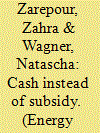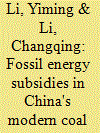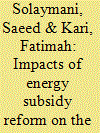|
|
|
Sort Order |
|
|
|
Items / Page
|
|
|
|
|
|
|
| Srl | Item |
| 1 |
ID:
186450


|
|
|
|
|
| Summary/Abstract |
The 2010 energy subsidy reform in Iran is a unique case of redistributive policy as the savings from the subsidy cut have been redirected to households as unconditional, universal cash transfer. While theoretically, the cash transfer was large enough to keep the utility of the average household at the initial level, this study explores the practical impacts of the reform. We analyze panel data on income/expenditure of Iranian households for the period 2010–2012. Since this is a universal reform, we exploit the time dimension and the intensity of energy consumption in the identification and assess the robustness of the results with sub-sample and placebo analyses. Overall, the energy subsidy reform caused a significant shrinkage (7%–9%) in households' real consumption. The cash transfer failed to fully compensate the negative impact of the subsidy removal. The impact is heterogeneous, varying along the intensity of energy consumption, geographical location, income and the share of the cash transfer in a household's income. A non-negligible policy accomplishment of the reform is that within its first two years poverty was mitigated in absolute and relative terms and income inequality slightly improved. Nevertheless, the government is under pressure because inflation counteracts these gains.
|
|
|
|
|
|
|
|
|
|
|
|
|
|
|
|
| 2 |
ID:
169867


|
|
|
|
|
| Summary/Abstract |
The issue of whether there is a fossil energy subsidy in China's modern coal chemical (MCC) sector remains controversial, although domestic coal prices have been liberalized since 2013. To identify potential fossil energy subsidies in the MCC industry, an inventory approach is used in subsidy measurement. Three representative forms of coal consumption subsidization are identified and measured in this paper: feed coal supply at a preferential price, prior access to coal mining rights, and privilege in coalmine M&A (mergers and acquisitions) cases. Using China's coal-to-liquids (CTL) industry as a case study, we find that the current subsidy helps save 50% of the coal consumption cost of a typical plant, and the total amount of subsidy in the CTL industry will reach 16.4 billion Yuan in 2022. However, according to the results of efficiency, wastefulness and effectiveness tests, 47.03% of the current subsidy in the industry is excessive, leading to overinvestment and energy waste. To compensate for the deficiency of the subsidizing mechanism, we suggest replacing subsidizing channels that rely on mining rights concessions or M&A cases with channels using long-term coal supply contracts that couple contract prices and oil prices.
|
|
|
|
|
|
|
|
|
|
|
|
|
|
|
|
| 3 |
ID:
177121


|
|
|
|
|
| Summary/Abstract |
Reforming subsidies for fossil fuels is a challenging prospect for many governments. The impact of such a reform on households is a major concern for the government. This paper investigates the heterogeneous impacts of eliminating energy subsidies on households in China from direct and indirect perspectives. The results of the direct effects show that the removal of energy subsidies, particularly for removing electricity and gas subsidies, has a greater negative impact on the poor than on the rich. From an indirect perspective, this article shows that the lower the per capita disposable income, the higher the proportion of consumption to disposable income, and the greater the indirect impact of eliminating subsidies. Meanwhile, the impact is not only related to household income but consumer goods. Moreover, the indirect effects of eliminating subsidies on households differ across energy types. Specifically, eliminating electricity subsidies has the greatest effect on households, followed by transportation fuel and gas. We suggest that targeted supportive measures need to be taken towards the implementation of subsidy reform, particularly in countries with greater inequality, to minimize the negative effects on the poor.
|
|
|
|
|
|
|
|
|
|
|
|
|
|
|
|
| 4 |
ID:
132762


|
|
|
|
|
| Publication |
2014.
|
| Summary/Abstract |
Malaysia is paying a high level of subsidies on the consumption of energy (about 5% of its GDP). Therefore, reforming the energy subsidies, as planned by the government, will have a significant impact on household welfare and energy-intensive sectors, such as the transport sector. This study employs a computable general equilibrium (CGE) model to highlight the transmission channels through which the removal of energy subsidies affects the domestic economy. The findings show that the shock increases real GDP and real investment, while decreasing Malaysian total exports and imports. The removal of energy subsidies also decreases the aggregate energy demand, and, consequently, decreases the level of carbon emissions in the Malaysian economy. In addition, households experience significant falls in their consumption and welfare. The transport sector is significantly influenced through an increase in production costs due to an increase in the prices of intermediate inputs. The total output and total exports of the whole transport sector decrease while its imports increase. In addition, the use of all kinds of transport by households decreases significantly. The Malaysian energy subsidy reform, leads to an initial decrease in CO2 emissions and demand for electricity, gas, and petroleum products in the entire transport sector.
|
|
|
|
|
|
|
|
|
|
|
|
|
|
|
|
|
|
|
|
|